#good omens costumes
Text
Maggie’s pendants and good omens
Yes, you’ve read it right. This post is going to deal with some literal good omens, not just title drop! But first things first, let’s take a closer look at the topic of this analysis.


A toucan
The top necklace is a lovely design involving a crowned toucan — believed to be a messenger of gods able to travel between the spiritual and the physical world, often associated with rain and rainbow (a Christian symbol of divine love, grace, and mercy, a reminder of the covenant between God and humanity to spare the latter from future trials like the Flood) — encircled by a gold band (a symbol of infinity, eternal love and promise) spun by a small butterfly (a symbol of transformation, hope, and rebirth). All three symbols combined seem to deliver a divine message of hope for rebirth, possibly resurrection, and the eternal life. Very fitting in the context of the Second Coming.
The fact that toucans were revered by the native South Americans as rainbringers strengthens the symbolic meaning of another type of bird we can spot on Maggie’s clothes in the very first episode, as her character introduction — a swallow. Swallows flying low are also believed to be harbingers of rain and bad weather. If you see one close to Earth or a building, it means that there’s a storm — or a certain biblical tempest — on the horizon.
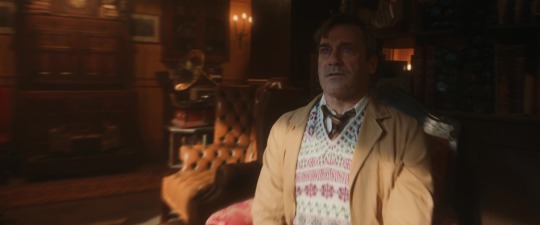
In Ancient Greece and Rome swallows were representing Aphrodite, goddess of love. In Christianity they were considered to be of God and symbolized hope, awakening, and revival of life as messengers of spring and protectors from winter colds. Also helped Jesus on the Cross — according to a Christian legend, a group of swallows was supposed to take out the thorns from the Crown of Thorns and alleviate His Passion on the Cross. Humans banding together in the name of good have been a big theme in the series ever since The Them made an appearance, and from what we already know about the unpublished Good Omens sequel, we can assume that Jesus is going to take the spotlight in the upcoming season.
Maggie definitely attracts sudden inexplicable weather changes, like a thunderstorm with weirdly localized lightning strikes or a sudden downpour. And we’re still waiting for some vavooming (and the following happy ending) to happen in S3.

A heart with an eye
Now, the more nuanced clue hidden in the bottom necklace. I know that some of us were trying to tackle the concept of Maggie’s eye in a heart pendant suggesting her Masonic connotations, but this symbol (or the Eye of Providence in general) isn’t strictly Masonic, it isn’t even limited only to Judeo-Christian art. And while it is used a lot in Christian iconography, we should focus on a very specific example of it already referenced in the show.
Buckle up, we’re making a parachute dive into S1.
It seems like our old friend, Agnes Nutter, still has our backs.

Prophecy 4020:
Let the wheel of fate turne, let harts enjoin, there are othere fyres than mine; when the whirl wynd whirls, reach oute one to another.
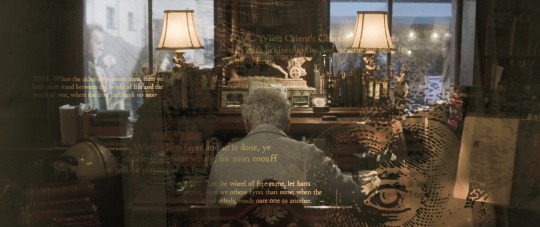
If you look closely at the bottom right corner of this frame, you will see that as an illustration for the above prophecy the production team chose a 1611 engraving titled The Minde should have a fixed Eye On Objects, that are plac’d on High first found in Gabriel Rollenhagen’s Nucleus emblematum selectissimorum.
In 1635 it was published in A Collection of Emblemes, Ancient and Moderne Quickened With Metrical Illustrations, both Morall and Divine, Etc by George Wither with the accompanying hymn:

A Heart, which bore the figure of an Eye
Wide open to the Sunne; by some, was us'd,
When in an Emblem, they would signifie
A Minde, which on Celestiall Matters mus'd:
Implying, by the same, that there is nought
Which in this lower Orbe, our Eyes can see,
So fit an Object for a manly thought,
As those things, which in Heav'n above us be.
God, gave Mankinde (above all other Creatures)
A lovely Forme, and upward-looking Eye,
(Among the rest of his peculiar Features)
That he might lift his Countenance on high:
And (having view'd the Beauty, which appeares
Within the outward Sights circumference)
That he might elevate above the Sphæres,
The piercing Eye, of his Intelligence.
Then, higher, and still higher strive to raise
His Contemplations Eyes, till they ascend
To gaine a glimpse of those eternall Rayes,
To which all undepraved Spirits tend.
For, 'tis the proper nature of the Minde
(Till fleshly Thoughts corrupt it) to despise
Those Lusts whereto the Body stands inclin'd;
And labour alwayes, upward to arise.
Some, therefore, thought those Goblins which appeare
To haunt old Graves and Tombes, are Soules of such,
Who to these loathsome places doomed were,
Because, they doted on the Flesh too much.
But, sure we are, well-minded Men shall goe
To live above, when others bide below.
And hey, guess what 4020, i.e., the number of the prophecy, symbolizes in Strong’s Concordance? Periergazomai, a Greek word meaning “to waste one's labor about something” — to meddle, going beyond proper boundaries (where a person doesn't belong); to fixate on what others are doing, instead of doing what the person himself is supposed to do.
It appears only once in the Bible:
2 Thessalonians 3:11: We hear that some among you are idle and disruptive. They are not busy; they are busybodies. Such people we command and urge in the Lord Jesus Christ to settle down and earn the food they eat. And as for you, brothers and sisters, never tire of doing what is good.
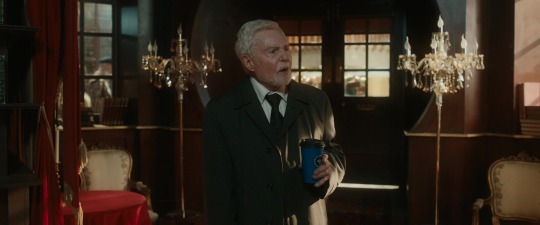
To make things slightly more interesting, in the Hebrew version of Strong’s Concordance 4020 has another meaning — migbaloth, meaning “twisted things, i.e. cords”. Which doesn’t make much sense until we read the actual passage:
Exodus 28:24 and two chains of pure gold, twisted like cords; and you shall attach the corded chains to the settings.
And compare it to the most recent post on the topic published directly by Word of God:

What if all these clues didn’t apply to Maggie and Nina, but Aziraphale and Crowley instead? What if Maggie served as a messenger — consciously or not — just like the toucan, delivering the prophecy to those who need it most?
“When the tempest comes and darkness and great storms, and the dead will leave their graves and walk the Earth once more and there will be great lamentations for the end is near, don’t lose hope, hold hands and look up.”

Basically what Aziraphale and Crowley already did when they performed the 25 Lazarii miracle, only with no interference from Gabriel this time around.
And, if both Strong’s Concordance and Maggie’s personal addition to her second pendant are to be believed, with a wedding band somehow involved in the process.
#everything has a meaning#the invisible and unbreakable line that joins Crowley and Aziraphale#two chains of pure gold twisted like cords#never tire of doing what is good#don’t lose hope#hold hands and look up#the good omens crew is unhinged#good omens props#good omens costumes#the nice and accurate prophecies of agnes nutter#agnes nutter#good omens#maggie service#good omens meta#good omens analysis#strong’s concordance#yuri is doing her thing#ineffable husbands#wedding bands
59 notes
·
View notes
Text

Good Omens x Wild West
Jumped on the transcontinental railroad to play around with how our ineffable husbands would look in the wild west.
Fun facts
Crowley hates horses and horses hate him
Aziraphale is posing as a doctor
Crowley has two guns, but doesn't know how to use them (Aziraphale does, though.)
Aziraphale has to keep miracling away his sunburns because he always forgets his hat (or loses it)
Edit because this is more important to me than it should be lol: not an AU! They're still Angel and Demon, it's merely canon-divergent I would say.
#good omens#good omens fanart#crowley#aziraphale#ineffable husbands#art#goodomens#wild west#good omens x wild west#good omens au#aziracrow#good omens costumes#concept art#character designs#characterdesign#character art#concept design#vavoomart
5K notes
·
View notes
Text
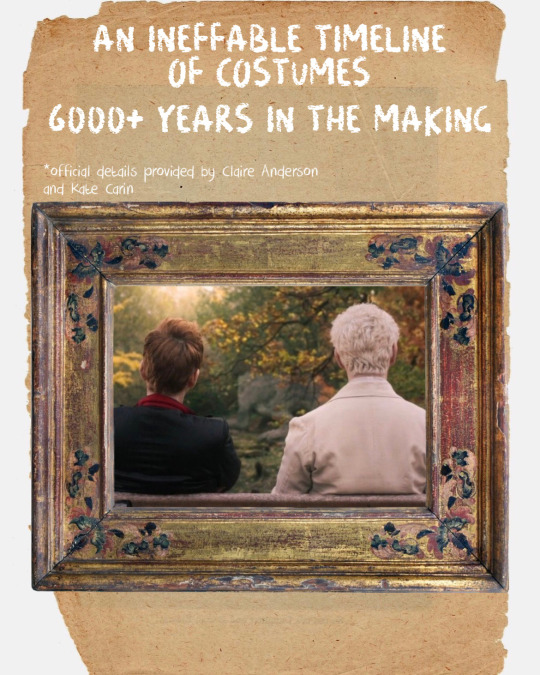
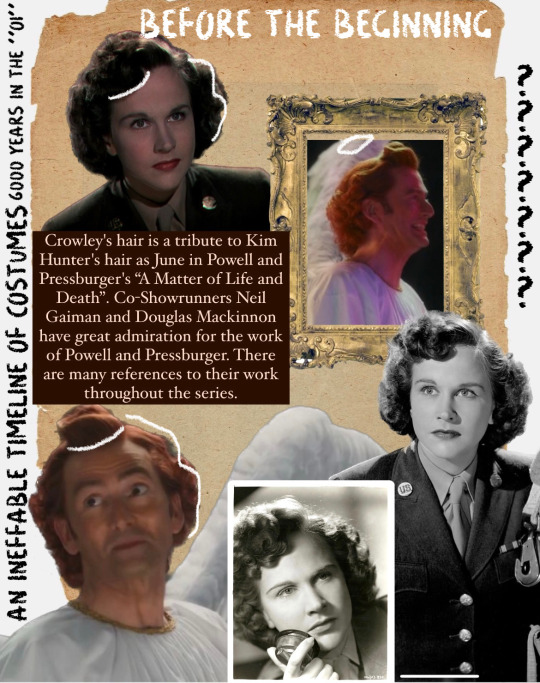





An Ineffable timeline of costumes: more additions!
Some of them taken from the trivia section in Prime Video and behind the scenes with Kate Carin.
Others taken from the TV script. (N.A. and brother Francis).
Part 1 is here. (And all links thus to other parts).
#crowley#good omens#aziraphale#ineffable husbands#good omens fun facts#neil gaiman#terry pratchett#good omens 2#good omens costumes#easter eggs
3K notes
·
View notes
Text
The costume details in Good Omens never cease to amaze me
I was working on cosplay research and looked up 'men's dress shirt rounded collar' since I noticed Aziraphale's blue dress shirt collar is rounded, not pointed:
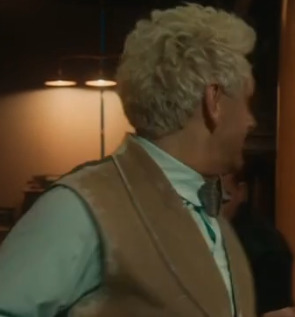
So it turns out...
"The rounded collar was part of Eton College‘s dress code beginning in the mid-1800s. Because men wanted to be perceived as belonging to this exclusive club, the rounded, or “club” collar was copied by the masses." (Source)
Between that and the fact that Aziraphale's waistcoat, from what I can find, most closely matches shawl collar waistcoat designs from the 1830s, and his waistcoat at Saint James Park in 1862 is the first one we see him wear that most closely resembles his 'modern day' one, it's safe to say our lad is stuck at the start of the 19th century.
Which COULD be hilarious given undergarment styles of the time:
Through the late 19th century - union suits! Lovely for cold London winters.
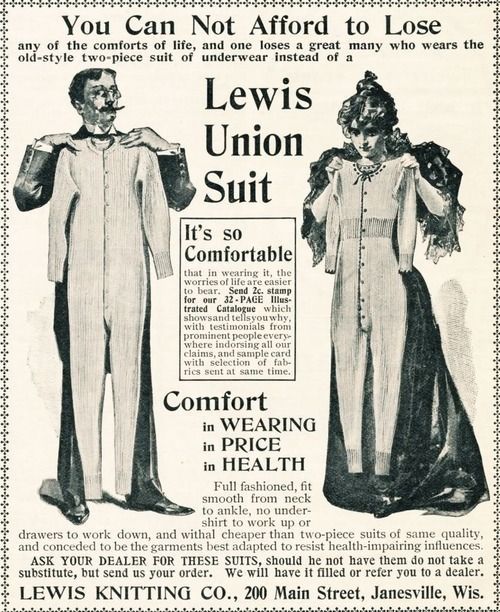
1907...
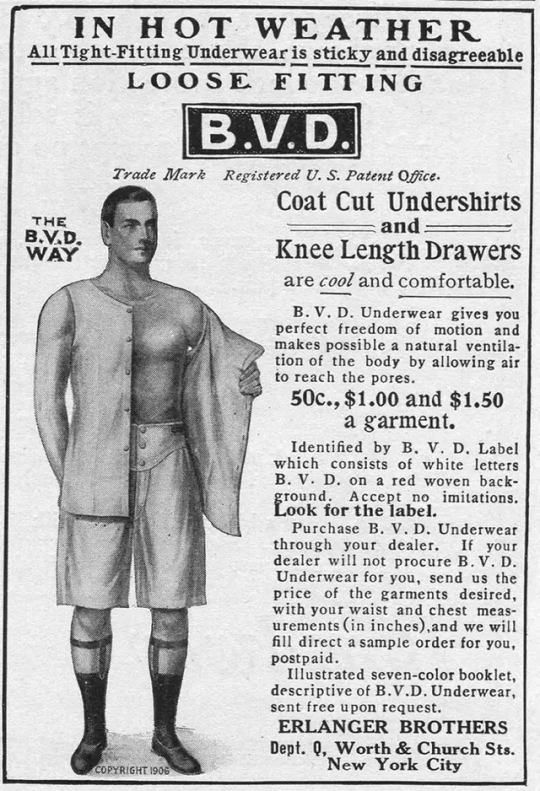
However, I suspect 1940s style to be most likely, as it seems to be what he emulated when pretending to be Crowley at the end of Season 1.
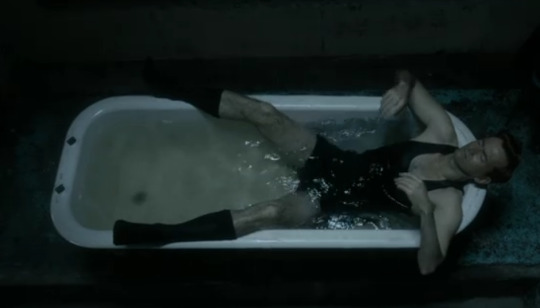
1940s undergarments:

Anyway this has been your fashion history dork brain dump LOL
#fashion history#historical fashion#good omens#good omens costumes#good omens cosplay#aziraphale#crowley#IneffabLeigh's Meta Tag
427 notes
·
View notes
Text
CORRECTED & UPDATED Clothes + Equivocation = Romance:
The Husbands in 1793 (Part 2)
From Part 1:
Crowley and Aziraphale share clothes as a common interest. They don't have the same style, but they're both aware of current fashions, and Heaven and Hell aren't. You can't tell me Hastur or Uriel would recognize the significance of Crowley saying "Dressed like that, he's asking for trouble" about someone else while wearing black stockings and cravat and waistcoat himself. And that means Anything the husbands communicate to each other through clothing choices goes undetected by their masters.
SO. With all this in mind, let's go through the 1793 scene again and look at what the husbands communicate to each other without using words or actions to do it, and how their clothing choices help them do that.
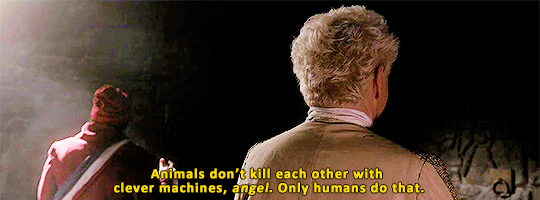
Hello. I'm here and I know you're in a spot of trouble. I like you.
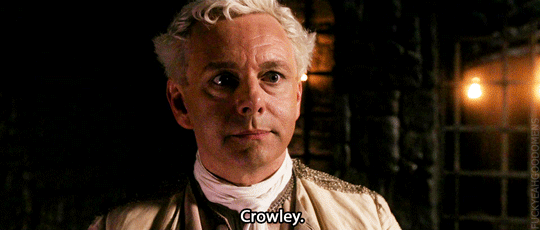
It's you! I'm so happy you're here!
Sheen's voice and face when Aziraphale says Crowley's name in this moment makes me think that Aziraphale is in love with Crowley--the demon Crowley, not the angel who became Crowley--long before he consciously realizes it in 1941. The way Sheen has Aziraphale say Crowley's name is so soft.

The way you're he way you're lounging there and what you're wearing are uncomfortably sexy and also incredibly inappropriate for the Bastille at this moment in history. I suppose this is very on-brand for you.
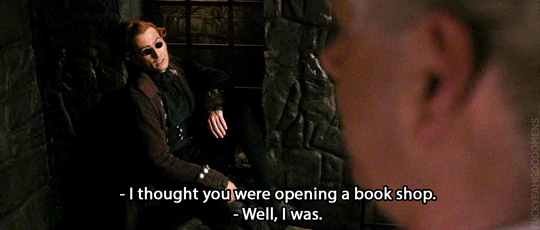
Crowley: I listen when you talk about your interests and goals and keep track of your general whereabouts and pursuits.
Either they've spoken with each other recently or Crowley has been keeping tabs on Aziraphale. Aziraphale isn't upset that Crowley knows what he's been up to, which suggests the former, which in turn suggests they're in semi-regular (every few years or decades) contact at this point.
Also we've now got a general idea for when Aziraphale opens his bookshop.
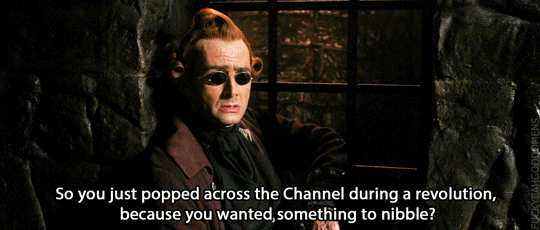
Okay, brief tangent while I point out two things here.
One, my favorite thing about Aziraphale is that he is a sensualist. This is libertine behavior, y'all. He 'popped across the Channel' during the Reign of Terror because he wanted a specific carnal experience of a specific really lovely food.
And two, even when Aziraphale does weird, frivolous, silly, ill-advised things like this, things that clearly baffle Crowley...Crowley never makes fun of him. He never laughs at him. He always has this look of disbelief on his face, like Am I hearing this?--

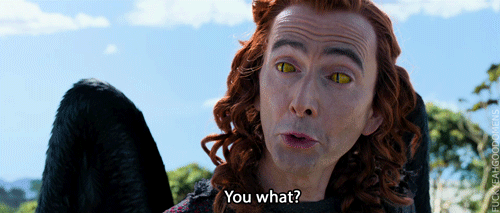
--but Crowley never, not once, shuts Aziraphale down.
Until Aziraphale asks him to go back to Heaven.
Anyway. Back to our scene.
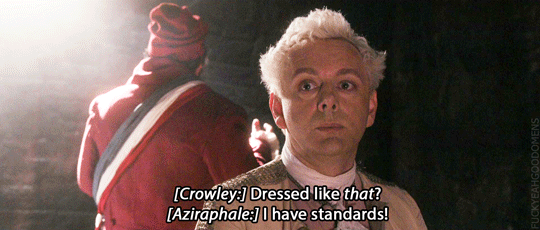
Aziraphale: I am unwilling to abandon my sartorial sensibilities even when it threatens my corporation, and I am insane, so I think this is reasonable. At least I'm not wearing a Slutty Monarchist outfit.

You're happy to see me, aren't you. You're relieved to see a demon. Go on, say it.
Tennant's delivery of this line cracks me up. It is so gloating and flirtatious and smarmy and indulgent of Aziraphale.

I am very happy to see you and lucky you're here, and I am willing to say so sincerely even though you are gloating about it.
And then there's the exchange where Crowley very carefully doesn't answer Aziraphale's question about why Crowley's in the area but also reassures him that he didn't cause the French Revolution and Aziraphale can still like him.
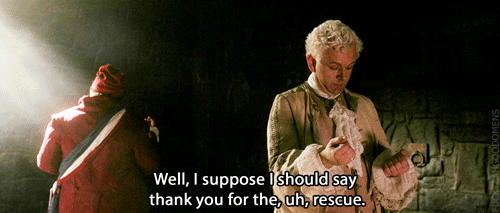

We can't speak openly about this. It's dangerous for me.
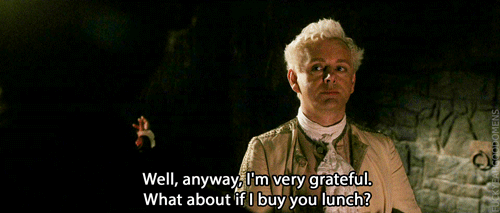
Message received: I won't mention what you did again. But I want to show my gratitude and spend time with you; is it safe for us to get lunch together?
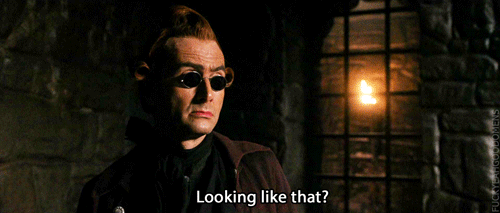
Yes, but one of us is going to have to change so we can walk the streets of Paris without getting arrested again, and I'm the one doing the rescuing here so it's not going to be me. Your 'standards' will have to take the hit.
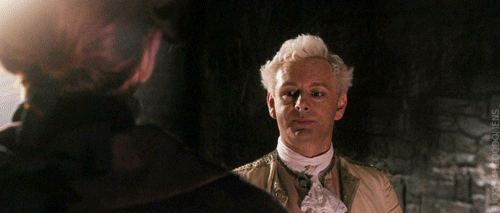
Fine, you've got me over a barrel. But hey, if I have to wear the silly hat anyway I might as well go all the way and wear your colors. Except not monarchist. And not slutty.
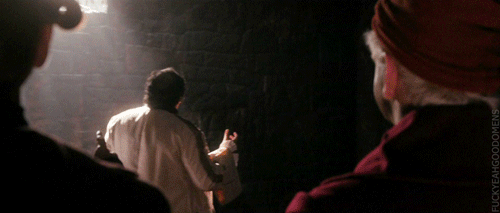

Oh, I don't know, I thought you looked pretty slutty too. (Meaning 2) I'm having this guy killed for touching you, btw. I will kill anyone who tries to hurt you. Immediately. I see you are having the guy who assaulted you killed in a copy of the clothes he would have killed you for wearing. I wholeheartedly approve of this (Meaning 3), your sexiness in those clothes notwithstanding. The utter insouciance of Crowley's little sniff and the inquiry about what they'll have for lunch drive home hard that Crowley could not be more unbothered by Aziraphale having the man who tried to harm him beheaded.
What really tickles me about this line is not only that Crowley's joke has three distinct meanings, but that Meaning 1 (the meaning that exists without reference to Crowley's clothes) is the opposite of Meaning 3--Anybody wearing clothes like that deserves what they get (Meaning 1) versus It rocks how you just killed someone who tried to kill you for wearing those clothes (Meaning 3)--and yet because of the clothes he's wearing, both meanings come through with perfect clarity, dependent only on whether the listener(s) can see his clothing and know its significance. Aziraphale can, and does, so he receives Crowley's real meaning. Hell/Heaven can't, and don't, so they just hear Meaning 1.

And then we get Aziraphale's pleased little smile and look of tranquil interest as he watches Jean-Claude dragged off to his death. Its such an interesting facial expression for an angel watching a demon have someone killed having someone killed, isn't it?
Crowley has just told him they're probably being listened to by Hell. That means Aziraphale, Crowley, and the audience all know this is the most Aziraphale can safely react. Aziraphale can't show any overt approval of anything an agent of Hell does, because by definition anything a demon does is demonic and angels must be against That Sort of Thing. In light of the fact that Aziraphale is the one who causes Jean-Claude's death, I now argue that this responsibility not to react too positively to something the other side has done falls on Crowley, and that the reason he makes this joke is primarily to tell Aziraphale I see what you've just done, and I like it without identifying aloud what exactly has just happened for their presumed eavesdroppers because an angel arranging a human's murder is the sort of thing in which head offices might take undue interest.
The awareness that their conversation is not private means the audience and Aziraphale know they need to be watching and listening for multiple meanings from Crowley, and it also means the audience and Crowley know we need to be watching Aziraphale's face closely right now. And that little smile shows us that Aziraphale has received Meanings 2 and 3 of "he was asking for trouble."
Or, at minimum, Meaning 3; even if Aziraphale picks up on Meaning 2--You looked really sexy in your vintage clothes, you crazy weirdo--that's not a message he can afford to react to at all. But he does react to the other coded communication Crowley is sending when he says "Dressed like that, he was asking for trouble" while dressed for trouble himself: I will kill anyone who tries to hurt you. Immediately. People who think your clothes give them the right to hurt you can go to Hell, and I am delighted you just sent one of them there.

You just had someone beheaded for assaulting me, I acknowledge and am pleased by your delight at my cleverness. and I could not be happier. Would you like to come enjoy one of my very favorite sensual pleasures with me?
***
EDIT: To be honest I like this reading better than my original, incorrect understanding of the story despite the fact that it is slightly less romantic, both because I love the idea of Crowley as a thirsty witness to Aziraphale quietly being a vengeful badass, because it gives us a glimpse of something important about Aziraphale's character that we don't get to see elsewhere: Aziraphale doesn't have a problem with killing per se.
We learn from the business with the Antichrist that, like Crowley, Az. can't bring himself to kill children. We learn from his perturbation at the Flood and the Crucifixion that he doesn't hold with killing innocents. He gave away his flaming sword. But this scene establishes that Aziraphale will actively cause someone's death if he feels they deserve it. That seems like an important character note for him that may become relevant in Season 3 (feathers crossed that it happens).
And I think there's something else in there too, something about how Aziraphale kills Jean-Claude, not with outright violence but with a trick. One party thinks he's in control of the situation; with a wave of his hand, suddenly a turnip has turned into an inkwell an executioner has turned into the condemned--or at least it seems that way long enough to get the job done. It's a bait-and-switch, like stage magic, and it slots right in to the motif in Good Omens of sleight-of-hand, of characters wearing other characters' appearances (for more on this, see fan theories re: Maggie is possessed), of supplying false meanings to an audience to disguise the true actions going on behind the scenes.
#good omens#good omens 2#good omens s2#good omens analysis#good omens clothes#good omens costumes#ineffable husbands#aziracro#azcrow#azicrow#good omens equivocation#good omens 1984#good omens clothing and equivocation#good omens 1793#good omens clothes and equivocation 2
553 notes
·
View notes
Text
Notes on Crowley's Red Highlights


I've just noticed Crowley's single red highlight in S2 thanks to this image. Crowley doesn't seem to have any highlights in his hair since it's done only with a red hair dye, save for one strand. (Second image by @fuckyeahgoodomens)
It's not a shadow or the lighting, it's a highlight and it's been there all along, but it always looks much duller in the episodes. For instance, some episode 6 screenshots:



And there it is, on the poster too. I think it was done with three different but adjacent foils that blend into a single thick highlight.
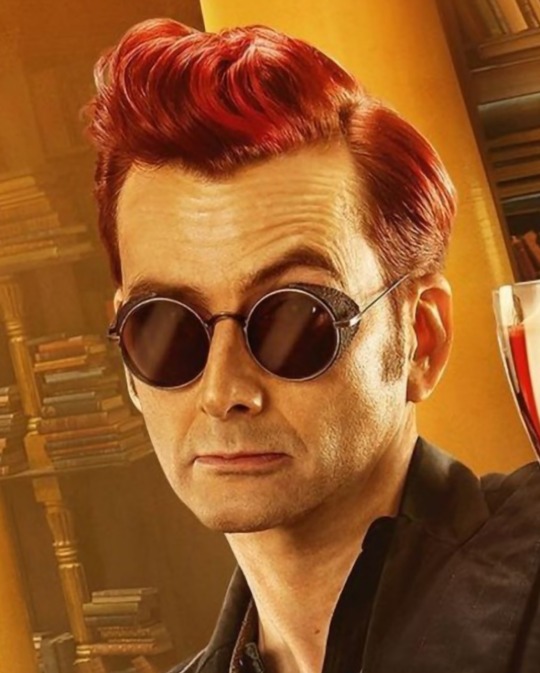
But look who's got some highlights of her own.


They are quite identical too, in both colour and thickness. Coincidence? A parallel? Or is she simply imitating Crowley?
Why add the single highlight in the first place?
I forgot to mention that Nina's also got the same highlights. See what they did there?

#good omens#good omens season 2#neil gaiman#crowley#good omens theory#good omens meta#good omens analysis#good omens costumes#shax good omens#ineffable partners#ineffable husbands#david tennant#crowley hair#good omens nina
284 notes
·
View notes
Text
I find Aziraphale’s tartan really interesting in the way it reacts to light
In a darker setting the blue stands out

but in a lighter setting it’s the red that stands out

reminds me of 3D glasses
#on other rewatch#sorry for the shit screenshots#honestly most of the time it looks like various shades of tan#good omens#good omens 2#good ineffable omens#good omens meta#aziraphale#a.z. fell#aziraphale’s tartan#good omens costumes#how does the costume department do it#beautiful bastards
243 notes
·
View notes
Text
Let's talk costuming: Avaunt!

So I think we can all agree that Aziraphale looks his most traditionally angelic in the Job minisode, no? In fact, all of the angels' costuming increases in drama for this particular episode. This is, obviously, a very deliberate choice on the part of wardrobe, so let's discuss.
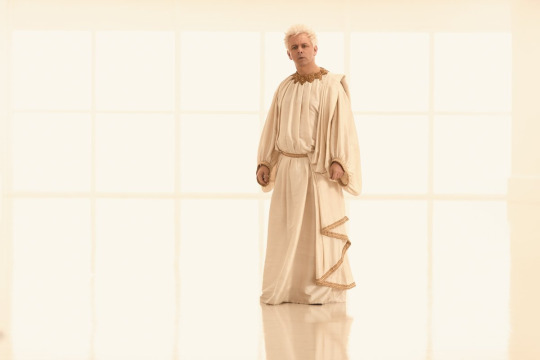
On a technical level, the biggest thing that stands out to me about this fabulous robe is the draping. Oh, the draping. It feels like a classic angel 'fit because on a very fundamental level, it is. A lot of what we think of as angelic draws on Renaissance artists' depictions, with flowing robes, fluffy wings, and glimmering halos. In art from this era, there is a strong attention to detail on the natural flow of fabrics that makes Renaissance sculpture so breathtaking, such as here: (The Ecstasy of St. Teresa, Bernini, 17th century CE)

It's this ability to make solid marble look like fine silk rippling with movement that leaves such a strong impression in my mind when I look at these kinds of works.
In painting, too, there is a similar effect. Something about the material culture of the Renaissance really lent itself to this style, perhaps fueled by the rise in new textile luxuries that occurred in vaguely the same period. This is seen especially strongly for angels, such as in the sculpture above, and in this painting: (The Annunciation to the Virgin, Botticelli, 15th century CE)

There's a stark contrast between the dress of the two figures. The virgin Mary is no less ornamentally or expensively dressed, but her style is rather minimalistic next to the angel's voluminous robing. It paints a very clear impression of angelic dress, and the designers for Good Omens would have been aware, in at least a small way, of the art history precedence for such a thing.
The poof of the sleeves, the tucks down the front, the little belt with the train tucked in, the gathers, the weight of the fabric, everything about this robe is constructed to carefully recreate the rather fantastical imagery of renaissance art. It's not necessarily an easy texture to nail down, given that the artists themselves had no concerns of gravity, comfort, or the way it would look in actual 3d motion, while our brave costumers were dealing with all three as well as a budget, time constraints, and the constant consideration that white fabric just gets dirty so easy.
Here's some of the other angels as well, so you can see how theirs reflect those same dramatic themes.

And then, of course, when costuming a show you have a second question: What does this mean for our character? Or rather, we know how, but WHY did they make him look so traditionally angelic?
Well, thematically, the Job minisode centers around Aziraphale's struggle with being a good angel and Crowley's struggle with being a good demon. Aziraphale is learning how to be an angel that follows along with heaven as far as we can, and he's so terribly torn up about it. He spends a lot of his time fretting about doing what's expected demanded of him, even if perhaps he doesn't believe it to be the right choice. Natural, then, that he should look the part of the perfect angel whilst sorting out these ethereal woes.

Crowley even draws attention to it himself, giggling a bit at the suggestion that Aziraphale, with his fluffy hair and flowing angelic garb, could possibly become a demon. And it is a rather silly mental image; the garment itself would be comically silly in really ANY other context at all. In the same manner, his performance of angelic archetype borders on excessive:

He's trying so desperately hard here to be the angel he wants to and is supposed to be. He's dressed the part, he's using his big scary angel voice, but deep down he's clinging to an identity that doesn't quite fit.
(You'll notice in this shot the distinct difference between his and Crowley's dress on the level of silhouette as well as color. We see this a lot from the two of them, but with the points I made above it felt worth pointing out in this particular scene)

Here at the end, as he's coming to terms with the cracks in his heaven-given identity, his robe is largely in shadow, blurring out its startling whiteness. We do not see him dressed this way again. (He continues to wear white, obviously, but from here on out his style of dress mimics the human trends of the time rather than that classical angelic imagery)
#good omens analysis#art history#sometimes I am an academic weapon but only when it doesn't count#aziraphale good omens#job minisode#costume design#good omens#good omens costumes#aziraphale#michael sheen#historical clothing#good omens 2#neil gaiman#also I love the little human touch of that little bend in his fucking sleeve cuff when he says avaunt#like that's a fully real piece of clothing that he's wearing not something animated and sometimes you just have to sit and appreciate it#it just makes me laugh a little#I'm sure someone somewhere agonized over it and wishes they'd fixed it but it just feels so human to me
335 notes
·
View notes
Text
Metatron's Tie
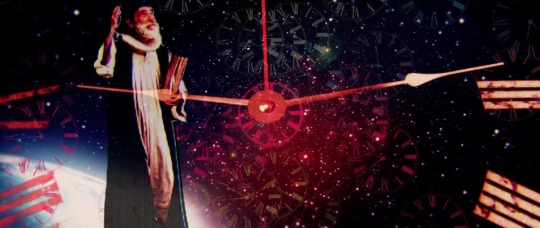
**Update: check the reblogs. There's a clear picture that shows the tie pattern as flowers. So, there goes my theory. Whomp whomp. Easy come, easy go, as Freddie says. @archangelween @drconstellation
People, I have been trying to get a good look at the Metatron's ding dang neck tie since September to determine what those little blue symbols are. Because, like everything in the Good Omens universe, I believe it's been put there for a reason. I also believe that God has no idea what she's doing, which is why she hired Neil Gaiman to run things for a few decades.
Despite being a so-called agent of Heaven, the Metatron's costume is coded as demonic, from his dark topcoat to the black stripes on his white shirt. The item I find most fascinating, however, is his tie. And this is probably in large part because I've had so much difficulty seeing the subtle blue pattern upon it and that has made my brain itch and made me hyperfixate. As one does.
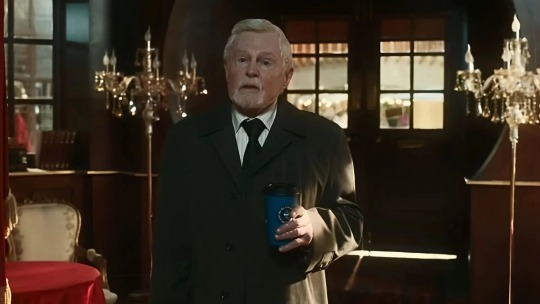
I think I may have figured out the design, and it complicates all my Metatron theories, but here we go. The Metatron's tie is black, featuring a repeated small bright blue symbol throughout. I've guessed it could be a star or a planet. A cryptic sigil or maybe something to do with the coffee (I'm not a coffee-theory person, though, for the record.) I don't know what it is (well, maybe I do now, and I promise we'll get there in time...I'm a demon of my word), but I do know that it's important.
All the angels have references to their angelic status concealed within their costumes.

Michael is the watcher. She is the one who, in Saturday Morning Funtime, delivers surveillance photos to Gabriel. To reflect this, Michael wears a gold ring featuring several small pearls that symbolize eyes. She is ever-vigilant (hyper-vigilant, ya might say), and even has a contact in Hell (Dagon) to broaden her scope of observation. The placement of the ring in the pinky is also significant. A good watcher mustn't themselves be observed, so Michael, in her role as observer must slip under the radar. This corresponds to the pinky finger being small and quite literally underhanded, as in at the bottom of the hand.
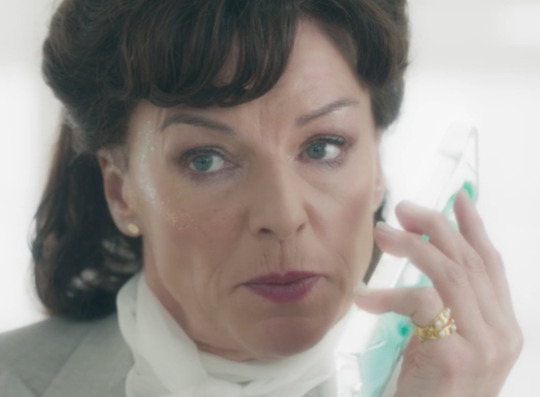
Uriel's ring is a silver star, worn on her/their index finger, the digit associated with authority. (We call it the index finger because we use it to sort and catalog, creating meaning and order.) Uriel certainly commands authority, both in their overall calm and assured demeanor, and also in their actions. It is she who physically confronts Aziraphale prior to the S1 No-pocalypse, easily inspiring fear in the Principality. As for the symbol of the star, I believe it is a reference to modern Angelography (I might have made up that word, but I think you know what I'm talking about) which usually describes Uriel as a sun, star, or the flame of the Almighty.

Sandalphon's symbology is two-fold: a thick gold pinky ring featuring a pair of circles (kind of looks like a lego brick, to be perfectly fair) and that small gold grill he wears on his front teeth. Both these items are the most elaborate pieces of angelic adornment that we see. Sandalphon's overall aesthetic is much warmer than the other angels', leaning toward caramel and tan rather than dove gray. He's a bit of an odd ball in the host of Archangels and stands out based on his wardrobe choices alone. He's also the only Archangel not to return in S2. I don't want to make too much of this, because there are many in-universe reasons why we may not see Sandalphon again. However, in Judeo-Christian scripture, Sandalphon is closely joined with...wait for it...the Metatron, with apocryphal texts describing him as Enoch's (the Metatron's pre-angelic human name) twin brother. I take this with a hefty spoon of salt, though, since Neil definitely plays loosey-goosey with these dogmas and even the scriptures themselves are a veritable soup of contradiction. (The Bible is not a static or universally canonical text, and Hebrew scriptures, outside the Tanakh are a web of activity and debate as to what is accurate. I'm not here for the arguments today; this is not my Bat Mitzvah.)
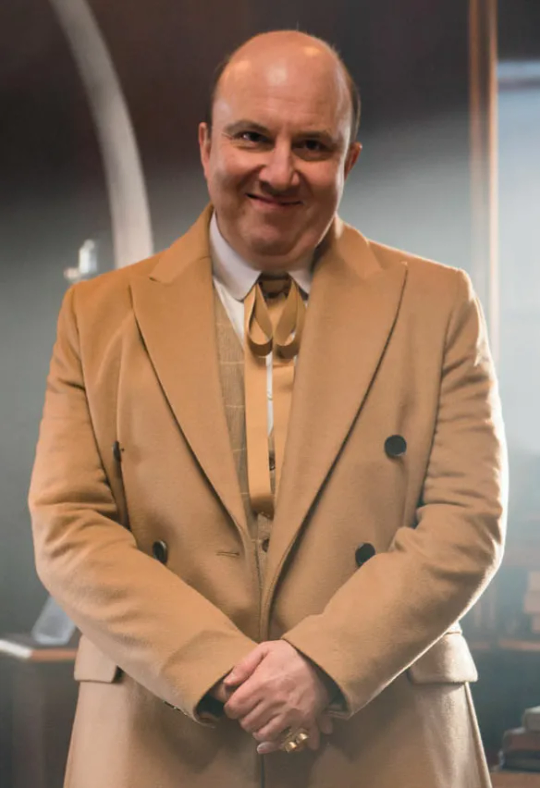
Finally, we have Gabriel, the only Archangel who doesn't wear a ring. He does, however, wear a watch. I have two thoughts about the watch. First, clocks are thematically relevant in the Good Omens universe. From the grandfather clock in the bookshop to Crowley's elaborate wristwatch (which he has in both show and book) to the opening sequence of S1, which has far too many clock faces to count. So there's that. But holding time in one's hand (or on one's wrist) is a powerful metaphor that illustrates control and higher power. To possess a clock is to command time and space which are essentially inseparable. As the Supreme Archangel, Gabriel is nearly the top-ranking being in the universe (for a time, at least...see what I did there? pathetic laughter) and his wristwatch demonstrates this point.

If you're still with me, you're doing great. Good job.
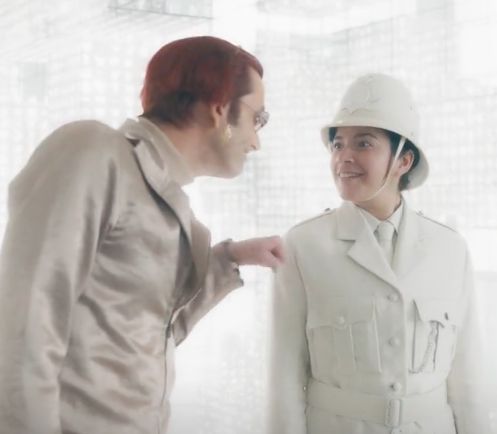
We've got to see how important the Archangels' symbology is to their characters, I think, to really understand why the sigils on the Metatron's tie matter. So, finally to the point. Dolphins. Thanks for coming to my TED Talk.

To move forward, we'll need to call upon my old friend, the Tarot deck. Cards, in general, and Tarot, in particular, play a marked role in the GO universe. The Almighty Herself addresses the viewer in the opening lines of the show, "God does not play dice with the universe; I play an ineffable game of my own devising. For everyone else, it's like playing poker in a pitch-dark room, for infinite stakes, with a Dealer who won't tell you the rules, and who smiles all the time." As God speaks, cards appear on screen, and some of those are from the Rider Waite Tarot deck. One specific card that caught my eye in this montage is "Judgement."
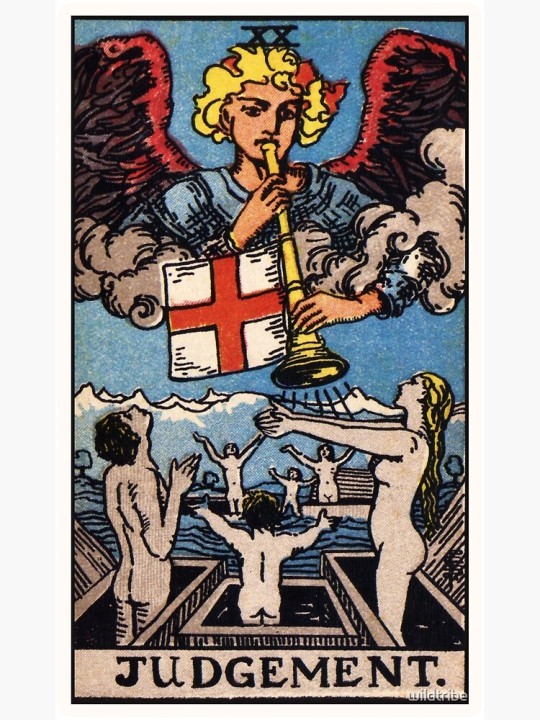
This card features an angel blasting a trumpet and waking the dead from their graves on the Day of Judgement. The angel on the card is not named, as such. It's usually assumed to be Raphael, as he is the angel who is prophesied to call and raise all souls on this day. However, I've found other references naming the angel as either Gabriel or the Metatron. Now, I don't want to get overly carried away here, but in the context of Good Omens, reading the Judgement card with the Metatron as the angel pictured may actually make a lot of sense, and clarify the sigils on the Metabutt's tie. The Metatron postures himself as the Voice of God--the Mouthpiece of the Almighty. Kinda like a trumpet, yes?

Now look at the flag on the angel's trumpet. That's called St. George's Cross and it's a very prevalent European Christian symbol dating back to the Middle Ages. Like many images in the Tarot, it's a heraldic emblem that has meaning outside the deck, often associated with bravery and military might. It continues to be used in military iconography into the present day. The Judgement that the angel heralds is not peaceful. It's a call to war. The righteous will be gathered to Heaven and the wicked will be destroyed--a repeat of the first Great War in which Satan and the demons were cast into Hell. In the narrative of Good Omens, this war will bring about the end of time, the end of the world, and the beginning of eternity (hope ya'll like The Sound of Music.)

Kids (human and goat, alike) I think those little blue sigils on the Metatron's tie are Saint George's Cross. (I'm so sorry this is so small and hard to see. Now you know my pain.)

In the Final Fifteen, the Metatron speaks briefly about the Second Coming, which is a reference to Saint John of Patmos' prophecies--you might know them as the Book of Revelation. Some Christians interpret Revelation as an upcoming final judgement for humanity. And it seems, based on in-universe exposition, certain characters view these prophecies in a similar light. In the reverse body-swap at the end of S1, Crowley suggests that the averted Apocalypse was not the end of the conflict. "If you ask me," he says, "Both sides are gonna' use this as breathing space before the Big One. [...] For my money, the really Big One is all of us against all of them." And with the Metatron acting as the Mouthpiece of God, that "Big One," that Day of Judgement, if you will, may well be nigh.
I think the Metatron sees himself as the angel who rings out the Final Judgement. He is the Voice of God, after all. But here is a worrying thought. How little he would need to shift perspective to view himself as the Word of God, as well. The Gospel of John opens, "In the beginning was the Word and the Word was with God and the Word was God. The Same was in the beginning with God." The Word of God is an epithet for Jesus. The same Jesus whose Second Coming the angel of judgement is meant to announce. So what if the Metatron just plans to consolidate these roles for himself: the heralding angel and the Second Coming rolled into one. He would become Judgement Incarnate, supplanting the Almighty once and for all. And for my money, that sounds just like what a demon would like to do.
***I'm updating because several readers have pointed out that it seems like I'm saying Metatron=Demon because Demon=Bad. Thank you for bringing this to my attention--it makes me a better communicator. I can see where it's coming from. It's not my intention. Consider this meta sort of an extension of my "Metatron is the Murder Hornet" meta, which I'll link with the tags if you're interested.
Just wanted to clarify that I think at its heart, Good Omens is thematically about rejecting the dichotomy of good and evil and embracing the messy gray space that is reality.
When I call Metaboob a demon, it's not because I think demons are evil, it's because I think he's the hornet in the beehive and we've seen that demons need an angelic escort (Crowley and Muriel) to access Heaven.
TL;DR Angels are not the good guys. Demons are not the bad guys. Good Omens is NOT about that at all.
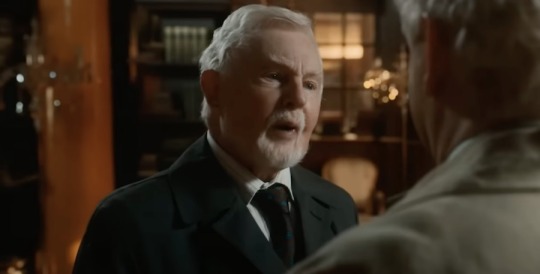
#good omens#the metatron#metatron#good omens 2#go metas#tarot#archangels#archangel fucking gabriel#archangel gabriel#archangel uriel#archangel michael#archangel sandalphon#good omens costumes#go costumes#youtube#metatron is a demon
176 notes
·
View notes
Text
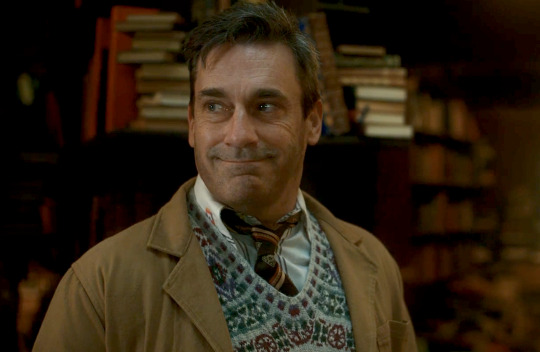
Jim's fair isle sweater vest/jumper... especially the bit right by the neckline that looks like an hourglass.
Little things to love about Good Omens S2 (19/?) - Masterpost
Detail:

*Edited edit: I found the knitter! See the reblog!
#look i have further thoughts about that sweater#like is it hand knit?#should i make a pattern for it?#you know#normal thoughts#i really want to know if it was bespoke or off the shelf#i really hope the former#good omens s2#good omens costumes#good omens costume design#i'll probably write a whole meta around this jumper one of these days#fiber arts#knitting#little things#jimbriel#jim good omens#gabriel good omens#a duck talks#good omens
297 notes
·
View notes
Text
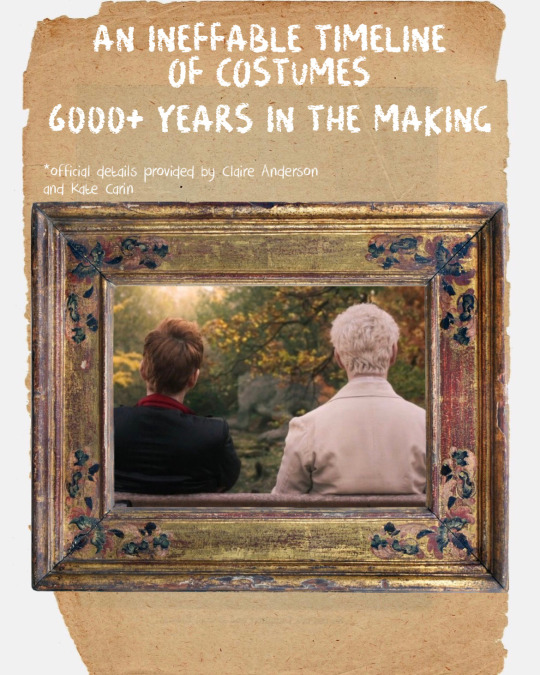







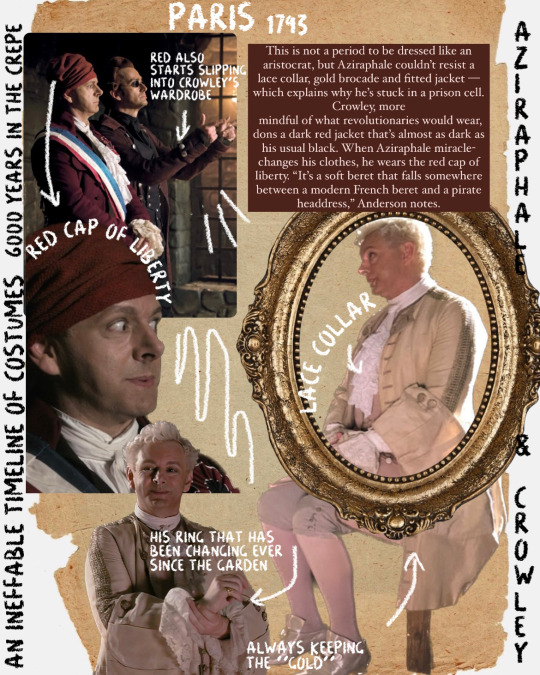

An Ineffable Timeline of costumes:
Where I gathered every official source detailing the costumes for s1 and s2. From interviews with Claire Anderson, lead costume designer for season 1 to Kate Carin, lead for season 2.
Part 1.
And part 2 and part 3. ♥︎
Extra!
If anything is not mentioned, it’s because there were no “official articles” talking about the costume.
Also because I have read some tags saying “this is not accurate” “this is not this” etc. , let me just remind you that the costume department is not here to make things 100000% accurate. Claire Anderson and Kate Carin both had the creative freedom to craft attires and make them believable for the time period. I collected all the sources in Part 3 if you want to read them yourself. This is about experimenting and giving it credibility without it being down to a T.
#crowley#aziraphale#good omens#good omens fun facts#ineffable husbands#neil gaiman#terry pratchett#good omens costumes
2K notes
·
View notes
Text


my 1890s inspired fem aziraphale 🤍
Photo by riikkisphoto (instagram)
#good omens#good omens 2#aziraphale#aziraphale cosplay#fem aziraphale#fem aziraphale cosplay#good omens cosplay#good omens costumes#ineffable spouses#ineffable husbands#ineffable wives#cosplay#costume making#desi tumblr
113 notes
·
View notes
Text
CORRECTED & UPDATED! Clothes + Equivocation = Romance:
The Husbands in 1793
EDIT: I made a significant error when I wrote this. As @goodjomans kindly points out in the comments to Part 2 of this essay (massive shoutout for this, goodjomans! also I love your name!), Aziraphale is the one who dresses the executioner in clothing like Aziraphale's original ensemble, not Crowley. This changes my conclusions about the meaning we can take from this scene!
On the one hand, mea culpa, y'all. I shall get on with eating my crow. On the other hand, I had to go through this frame-by-frame to catch which of the ineffable spouses puts Jean-Claude in his new togs, and the answer only lasts three frames. Here it is:
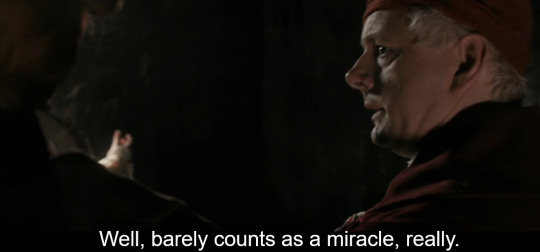
After Aziraphale changes his clothes, but before Crowley snaps his fingers and unfreezes time, there's a shot of the executioner over Crowley's shoulder, and he is now wearing a light coat with gold embroidery on the shoulders like Aziraphale's. Aziraphale arranges the executioner's death, not Crowley. So I feel like an idiot for missing it, but not a total idiot.
Let's discuss how this information changes what we can read from this scene! I'm going to leave my original text in place and edit with bold green. I can still stand by most of this essay, but this detail changes how I read the meaning of the husbands' communication at the end of this scene.
So we're all clear on the fact that the universe of Good Omens is an inescapable nightmare dystopia in which either of the husbands' merciless authoritarian regimes could be watching or listening to them at any time, yes? And that if either are caught 'fraternizing' with the other that means discorporation, torture, memory wipe, and/or death for either or both of them, yes?
Which means Crowley and Aziraphale can never speak or do anything openly to each other about their friendship or attraction or love. Everything they say and do has to have an innocuous meaning they can point to in case anybody ever sees or hears something Team Azcrow can't explain away. Walls (and ducks) have ears, and the price of slipping up--as we see in 1827--is heavy.
When a character says or does something that has two distinct meanings because they need to disguise what they really mean from one party but make their meaning plain to another, lit-nerds (and lit nerds🍃) call this equivocation. Equivocation is a kind of coded communication meant to pass hostile ears and eyes in plain sight but reach its intended recipient with its true meaning. The 1793 scene is jammed with it.
A lot of that coded messaging revolves around the clothes Crowley and Aziraphale choose in this scene, so--THESIS PARAGRAPH, BITCHES--we're going going to talk about how their clothes read to the people of this time period and location, what their clothes tell us about their characters, how their clothes help them equivocate, and what they're really saying with that equivocation. And Spoiler A-fucking-lert, it is ROMANTIC AF PRETTY GD ROMANTIC. Let's get nerdy!
We start with Aziraphale's beautiful champagne-gold and powder-pink ensemble.


This outfit would tell people of this time period 3 things about Aziraphale:
That he's insanely wealthy--These clothes would be silk, hand-embroidered with thread made with actual gold. Each individual garment could cost years' or even decades' worth of working-class wages and take a team of skilled artisans dozens to hundreds of hours to make.
That he's a fop--i.e., a man who loves fine clothes and dressing up and looking fancy. By the 1790s in England, once-fashionable foppishness was giving way to the Neoclassical 'Corinthian' style, and was considered effete. (Fun note: During this time period, effete did not automatically indicate gay, and pink was considered a masculine color, so while Az. is queering it up to the audience here, his clothes would not have read as gay or overtly effeminate to the other characters around him.)
Even though he's insanely wealthy, Aziraphale wears clothes that are decades out of fashion.
According to the Victoria & Albert Museum, "As the [18th] century progressed, the male silhouette slowly changed.[...] Coat skirts gradually became less full and the front was cut in a curved line towards the back. Waistcoats became shorter. The upper leg began to show more and more[...]. Shoes became low-heeled with pointed toes and were fastened with a detachable buckle and straps or ribbon[.]
Source
That description is not what Aziraphale's wearing. Judging by his heel height and the length of his waistcoat, Aziraphale is wearing a style that's at least a decade older than this:
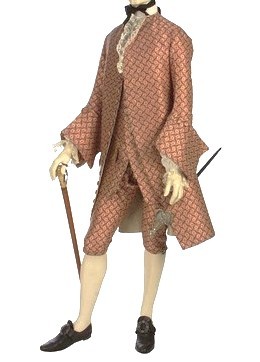
And this is from 1765. The great crepes caper happens in 1793, almost 30 years later.
My inference: Just as he has in the modern period, Aziraphale has settled into a style he really likes and refused to let go of it long after it's gone out of fashion.
We'll come back to this set of Aziraphale's clothes in a bit, but we need to talk about Crowley's first, because Crowley's clothes in this scene help render a line he says later about this outfit very flirtatious and darkly romantic.
First, some background: What was considered acceptable attire for wealthy people in France changed pretty much overnight during the French Revolution after the storming of the Bastille in 1789 and the fall of the French monarchy. Instead of advertising wealth, clothes now had to advertise political allegiance, and they had to do so loud and clear. And if you didn't want to be murdered by the French First Republic, that political allegiance had fucking better be to the Revolution.
People started wearing a looooooot of super patriotic shit. And I mean it was like little kids on the 4th of July; clothes were red, white, and blue in any hue and garish combination and print. The cockade, a fabric rosette in the colors of the French flag, was required by law to be worn by men, and despite that was just as popular among women. To show solidarity with the laboring classes, the fabrics the wealthy wore went from embroidered silk in light Rococo colors (what Aziraphale is wearing) to sober neutrals without decoration in wool, cotton, and linen.
Now, the script note for Crowley's clothing in this scene is this:

But clearly there were some changes made between script and filming, because Crowley does not appear standing behind Aziraphale; he appears lounging.
And he's not dressed as a French peasant.
Here's how French peasants dressed in 1790:

Peasants at this time wore styles that distinguished them from the styles of the upper classes not just in materials, colors, or patterns, but in shapes. Full trousers and cropped boxy jackets in French flag colors were the marks of the laboring-class Revolutionary, and both styles were huge changes from hundreds of years of French fashion up to that point.
And that's not what Crowley shows up wearing. Crowley is wearing the knee breeches, stockings, waistcoat, and frock coat of a wealthy man, and in fact his clothes reference a very specific type of wealthy man.
In the 1790s, if you were an aristocrat who wasn't happy about the Revolution and you were so sure of your privilege that you would risk your life showing it, you wore black in mourning for the monarchy and in protest of the violence of its deposition. If you were an aristocrat who wanted to protest and you didn't want to be immediately murdered by the French First Republic, you wore a style called half-mourning, which was black with a colored coat.
Here's a picture from a 1790 fashion magazine of an aristocrat in half-mourning:

"The text accompanying the plate describes his ensemble as 'half-mourning,' referring to the aristocrats who lamented 'the diminished powers of the monarchy and [signaled] their willingness to die for the royal cause'" [emph. added]. [Source]
Notice: the shoes, stockings, breeches, waistcoat, and cravat are all black. You with me?
Because here's Crowley in 1793:

I've turned up the brightness and exposure in this image so he's more clearly visible against the stone, but I haven't warmed it up. He's wearing a coat that's a dark blackish red. Everything else, even his cravat, even his shirt, is black. (The black shirt is anachronistic, a lovely little nod to Crowley's refusal to wear angelic white.)
This is 179fuckin'3, y'all. Marie Antoinette is executed in 1793. It's 3 full years after that fashion plate up there in his bright red jacket, and that lil dude was already risking his neck way back in 1790. As we can see from the fact that the government are apparently now grabbing random wealthy-looking Englishmen off the street to murder without trial, the time for a man demon to be sauntering around Paris dressed in all black or even nearly all black is well past.
Crowley's also wearing a whole assload of huge silver buttons, which would have been flashy and tacky and frankly pretty weird in 1793 but very definitely an eccentric Rich Person Thing to do, bc regular buttons at this time were horn or wood and covered with the garment's fabric. The only man in France who could get away with this fancy aristo shit anymore was Robespierre himself, and only "devotion to the cause[...] excused Robespierre’s showy dress since he was perceived as a bridge between the politically empowered bourgeois deputies and the ardently antimonarchical unenfranchised classes." [Source]
So when Crowley teases Aziraphale--
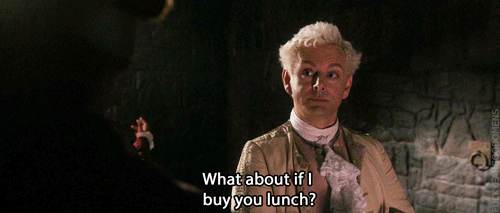

--both of them are perfectly well aware that Crowley's outfit would get him just as killed as Aziraphale's.
And that's why Aziraphale's expression is annoyed when he has abandon his "standards" and change his clothes. Because Aziraphale's the one who needs the favor, Crowley makes him take one for the team and wear the goofy hat.

The clothes Az. changes into here still tell people that he's rich, but they also say he's a hardcore Revolutionary. The red jacket in a current cutaway style, the cockade and sash, and the bonnet phrygien (the red garden-gnome cap) all announce this guy is a huge supporter of the Revolution. His clothes are all still aristocratic in shape and materials (and he keeps his now-unfashionably frilly lace cravat), but he's no longer flaunting obscene wealth in a city filled with angry starving people, and the gnome cap says he's in solidarity with the working classes even if he isn't one of them.
Once he restarts time, Crowley is not leaving that prison cell safely without either changing his clothes or taking Aziraphale with him, because Crowley looks like a rich asshole protesting the fall of the monarchy--which is frankly exactly the kind of thing he'd show up wearing to the Bastille during the Reign of Terror (just like he wears athleisure in Heaven). But Aziraphale's new appearance covers for them both: if the rich-looking guy with no cockade and wearing all black under his almost-black coat is in with this other guy who's obviously a Revolution fanatic, then the rich guy's probably okay, right? He just forgot his sash at home or something. Bees.
Something else happens when Az. changes, too. Look at Aziraphale's new dress from a different angle:
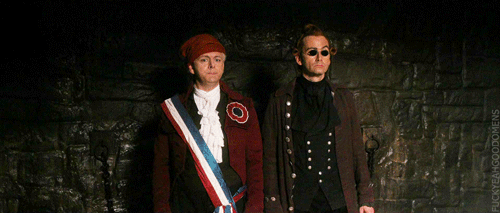
Half-mourning is a white shirt, but a black cravat, so this isn't half-mourning. He's wearing three different badges of the Revolution to make up for the fact that Crowley looks like a Satanic libertine (which tbf he is), but Aziraphale's new ensemble is black and dark red.
Y'all. Aziraphale changes into Crowley's colors.
Now, this is a more fashionable and higher quality version of what the executioner is wearing, so Aziraphale has very plausible deniability here; if anyone ever pulled him up on it, he could say he just copied our man Jean-Claude.
But let me show you what English fashion looks like right now:
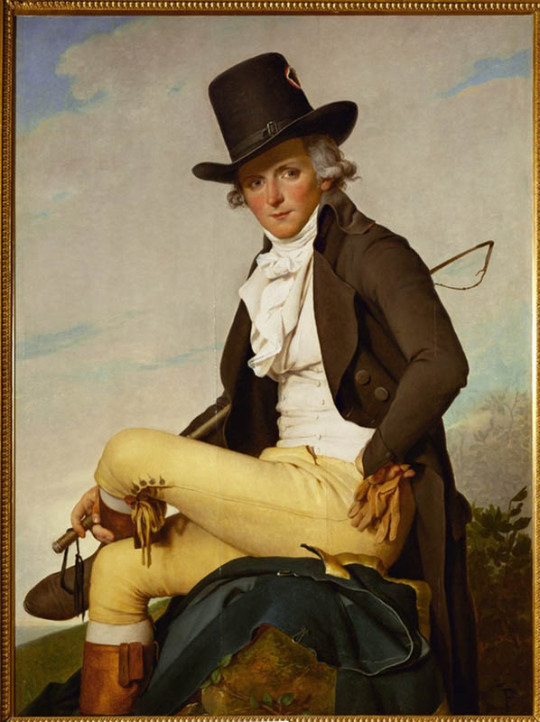
This is a French painting of a wealthy Frenchman, but he's wearing the English 'Corinthian' style. It was painted in 1795, so this would have been the very cutting edge of fashion in England in 1793, and the fabrics and colors look right at home in Revolutionary Paris. (He's wearing the cockade on his hat, btw.)
Look at all that angelic white! The buttery almond of the buckskin breeches, the golden kidskin gloves, the rich tan of the riding boots! The blue of the greatcoat! All colors we know Aziraphale prefers!
And yet this is what Aziraphale chooses:

We know from the entire rest of the show how very particular about his clothes Aziraphale is. And yet 150 years before he (accidentally) admits in words that he's Crowley's friend, Aziraphale wears Crowley's colors to take him to lunch to say thank you for a rescue.
When we decide whether a character's speech or action is equivocation, one of the things we check is whether equivocation (and deception generally) is something that character does elsewhere in the text, which, with Aziraphale, hahahahaha, DUH. He's already using equivocation in this scene.
The lunch date itself is equivocation on Aziraphale's part. Aziraphale tries to thank Crowley for the rescue, but Crowley says,
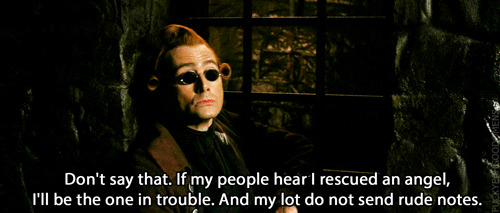
So Aziraphale says,

No more words like "thanks" or "rescue" used, but a couple hours of good food and drink and conversation, Aziraphale hopes, will express the gratitude toward Crowley it's not safe to speak aloud. With this, Crowley and Aziraphale explicitly establish that they are equivocating for each other's safety and using coded communication--immediately before Aziraphale changes into Crowley's colors.
So yes, Aziraphale may well copy the executioner's clothes. But consider: When a character who can't speak or act openly says or does something that has two or more possible meanings, this can be read as equivocation.
We don't get a face reaction from Crowley about Aziraphale's new 'fit, so we can't be sure how he feels about this. But this whole scene is, even on its surface, about 1) the meaning clothes transmit to a viewer ("Oh good Lord," says Aziraphale when he sees what Crowley's wearing) and 2) how to show gratitude and appreciation when you can't speak of them openly. And we know Crowley notices clothing and clothing colors, because look at what he wears, like, ever. So it's very reasonable to presume he notices Aziraphale wearing his colors, and it fits well with both the rest of Crowley's actions in this scene and with his being very hurt and angry when Aziraphale later characterizes their interactions as "fraternizing."
Right, so we've covered what's going on with the husbands' clothes, and we've looked at two examples of equivocation on Aziraphale's part, viz., lunch and his change of colors. (Here's an example of equivocation on Crowley's part as well.) Now let's look at that super interesting thing Crowley says about Aziraphale's first outfit.
Here's the line:
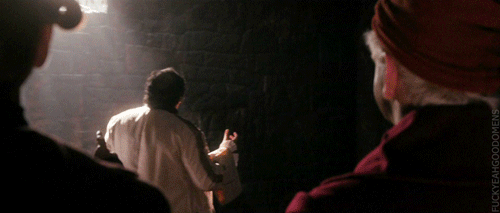
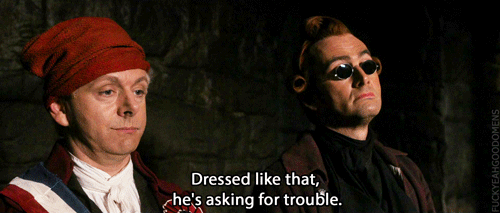
Crowley follows up here on earlier lines in which he teases Aziraphale for coming to Reign-of-Terror Paris for crepes: "Dressed like that?" meaning Aziraphale was guaranteed to get arrested dressed like an aristocrat. The top layer of equivocation is always an innocuous meaning: the plausible deniability meant for the hostile/unsafe listeners. That's Meaning 1.
But "Dressed like that, s/he's asking for trouble" means two other things, too. It's a veeerrrrry familiar phrase, isn't it? We've all heard that arrangement of words in that order before. It's used when people think someone (usually but not always a woman) is dressed to invite sexual attention.
How do we know we're supposed to take this modern meaning from this phrase? This is how:

We have learned in literally the previous sentence to this one that rain has not been invented yet. The only two humans in existence have just left the Garden. Balloons definitely do not exist yet, humans couldn't tell you what lead is, and yet this is a phrase Crowley uses and Aziraphale understands. This tells us, the audience, in the very first line of the very first scene with these characters, that their speech is anachronistic and modern, and that we are to understand their phrasing in its contemporary sense.
So. When Crowley says "Dressed like that, he was asking for trouble" in 1793, we should read that in the context of the scene and in the senses the phrase carries to us today.
And since Crowley is using a phrase that means the executioner is dressed to invite sexual attention, and the executioner is wearing clothes identical to Aziraphale's, then Crowley is necessarily telling Aziraphale that when Aziraphale was wearing those clothes--those frilly, effete, unfashionable-for-decades clothes that nobody else likes and the French now murder people for wearing--that was, in Crowley's view...provocatively sexy. Meaning 2.
"Dressed like that, s/he was asking for trouble" is also what people say to justify violence, especially sexual violence against women and queerphobic attacks against men perceived as gay or just 'insufficiently' 'masculine'. In fact justifying assault is likely the most common way this phrase is used today by a wide margin. Meaning 3.
Crowley's joke isn't even really a joke in this sense; it's a vicious barb. And, because it must, it sounds like it's at Aziraphale's expense: You wore the wrong clothes, you weren't careful enough to guard yourself against the men who want to do you harm, so you deserved the trouble you got. Meaning 1.
Except remember: Crowley is also dressed for trouble. And Aziraphale is aware of this. Crowley's 'fit would be almost as offensive to the Revolutionary French of 1793 as Aziraphale's Rococo pastels, and probably just as likely to get him arrested and murdered by the state if he weren't making letting Aziraphale keep him safe by wearing the cockade and the silly hat. Crowley's not saying anything about Aziraphale here that he's not also saying about himself; and as we know from Aziraphale's initial "Oh good Lord" when he turns around and sees Crowley's black and red half-mourning (with extra black and gobs of silver), Aziraphale knows it.
Then why the rapey joke, Crowley?
This is fucking why:
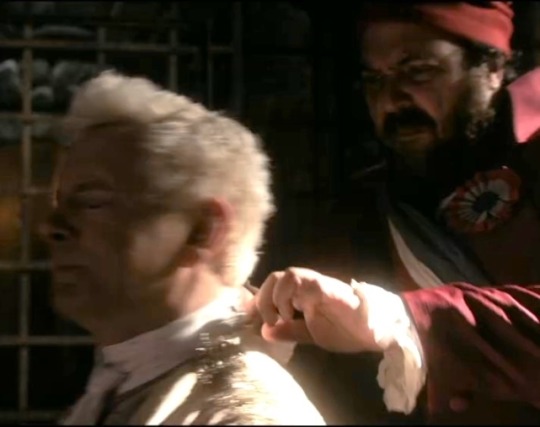
Crowley rocks up at the Bastille just in time to witness some grubby fucker assault his friend. Assault the person Crowley will greet 15 seconds after this as angel.
Crowley's first act after freeing Aziraphale is to send this dude to his death. Nope! Aziraphale is the one who arranges to have the executioner killed in the clothes he would have killed Aziraphale for wearing. He takes Jean-Claude's ability to speak (but not to make sounds, interestingly! Jean-Claude can still whimper, Jean-Claude can still cry!) so the executioner can't tell anyone about the 'mixup.' It's unclear which of them blocks the executioner's power of speech. The vicious joke about assault in Meaning 3 isn't at Aziraphale's expense at all. It's not You wore the wrong clothes, so you deserved the trouble you got. It's If this guy thinks you deserve trouble for wearing the wrong clothes, he can eat his own rules.
And that's the other piece of evidence that, along with Crowley's ensemble, shows us the audience and Aziraphale which meanings Crowley intends with his equivocation. Meaning 1 is cancelled out by Crowley's clothes. That leaves Meanings 2 and 3.
Crowley and Aziraphale share clothes as a common interest. They don't have the same style, but they're both aware of current fashions, and Heaven and Hell aren't. You can't tell me Hastur or Uriel would recognize the significance of Crowley saying "Dressed like that, he's asking for trouble" about someone else while wearing black stockings and cravat and waistcoat himself. And that means Anything the husbands communicate to each other through clothing choices goes undetected by their masters.
SO. With all this in mind, let's go through the 1793 scene again and look at what their clothes help them say without words.
Concluded in Part 2!
#good omens#good omens 2#good omens s2#good omens costumes#good omens fan theory#good omens meta#good omens analysis#aziracrow#azcrow#ineffable husbands#aziraphale x crowley#azicrow#good omens 1793#good omens 1984#good omens clothes and equivocation
548 notes
·
View notes
Text
Good Omens Cosplay
Furfur's scarf / cravat
A knitting pattern

In the original costume pictures, Reece very kindly shared, Furfur's scarf is made out of a strip of distressed fabric.
In the final shots of the series, probably due to the colour grading, it looks a lot darker and more like a seed stitch knitted scarf. It inspired me to knit one for myself.
Maybe it's useful for your cosplay or for some everyday Furfur bounding.

You need:
Yarn: 1x Scheepjes Metropolis in the colour Depok approximately £7,-
Or any 50gr / 200m skein of fingering weight yarn.
Knitting Needles: 2.75mm / US 2
Pattern:
Cast on 23 stitches
Row 1 - Row 8: Knit all stitches
Row 9 - repeat until desired length: Knit 1 Purl 1 until the end of the row (seed stitch) always starting and ending with a knit stitch.
Knit all stitches of the last 8 rows, bind off and weave in the ends.
You need to be able to wrap the scarf around your neck and knot it in the front twice + extra length to tuck in. I made mine around 140cm / 55 inches
Give it a gentle soak in a wool wash and block evenly.
You can distress the fabric you created or leave it for a polished Earth look.
You're going to be in a Knit 1 Purl 1 Hell loop for a while, but it's totally worth it!
Put Depeche Mode on repeat and sing along, watch Good Omens again (and again) binge watch Inside No. 9 (because you definitely should)
Tadaa: scarf 💚
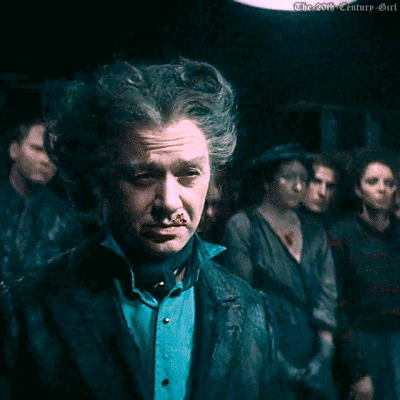
Now go block some miracles in style, give Shax a fist bump from me and work towards that promotion you so much deserve.

You can add it to your Ravelry here:
#good omens furfur#furfur#good omens#good omens cosplay#good omens costumes#good omens knitting#cosplay pattern#furfur good omens#good omens fandom#good omens details#reece shearsmith#knitting#knitting pattern#knitting project
43 notes
·
View notes
Text
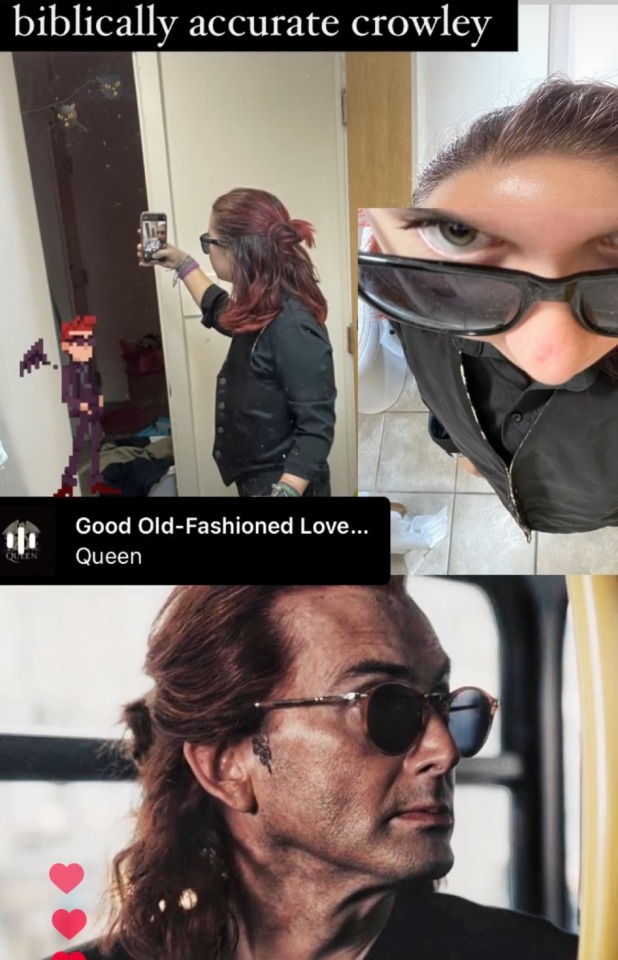
crowley costume!!!!!!!!!!! more photos to come?
#good omens#good omens season 2#go2#aziracrow#azicrow#aziraphale#crowley#neil gaiman#michael sheen#david tennant#good omens cosplay#good omens costumes#good omens costume#good omens 2#halloween#crowley costume#crowley cosplay
70 notes
·
View notes
Text
Mr Brown's Ensemble at the Ball
I think this officially marks the moment I've moved from obsessed to completely unhinged. It was only a matter of time. Welcome one and all! Here I loose my mind over the fact that Mr Brown is seen revived in line for the coffee shop wearing his outfit from the Dirty Donkey, NOT his outfit from the ball. But to back up, let's start here:

There's already been theories about how Mr Brown's outfit at the Whickber’s Street's Ballroom Meeting resembles Crowley's from when they met at the pub because Mr Brown has a pash on Aziraphale (also infamously blogged about here). Just as a reminder (in case anyone could forget) I'm referring to this outfit...
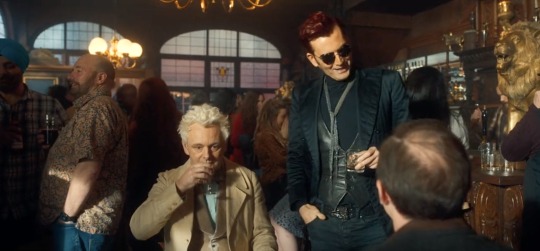
And the fact that Mr Brown shows up at the ball in a turtleneck and vest and jacket much like we see above, however with the vest and jacket in tartan that looks suspiciously similar to dear Mr Fell's bowtie.
I had headcanoned that Mr Brown dressed himself like this at the ball on purpose to catch Aziraphale's eye, but upon latest rewatch I caught this:
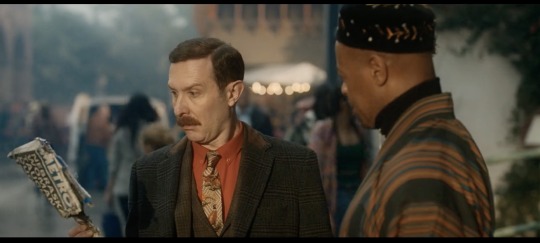
The next morning, Crowley brings Mr Brown back wearing the exact same outfit that he was wearing from the other day at the Dirty Donkey:
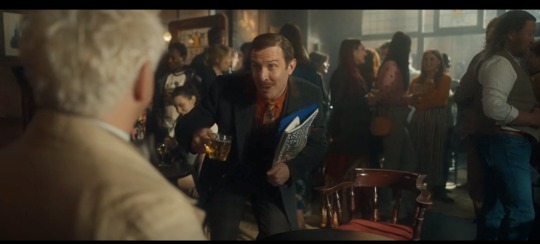
Aaaand this is where I completely lose the last shred of my sanity to this show. Does this mean
Crowley noticed Mr Brown dressing like him and did not care for it and deliberately brought him back in the outfit he'd seen him in before??
The outfit was miracled, and when Crowley brought Mr Brown back from the dead (have we confirmed officially that he died? I can't remember) or from whenever he’d been in the demon’s clutches, he brought him back in his pre-miracled outfit, either on purpose or because the miracled outfit had disappeared upon death/whatever happened to him?
Furthermore, if Aziraphale is miracling the outfits, then he miracled Mr Brown's ballroom ensemble to both look like Crowley's usual outfit AND complement his bowtie?!? SCANDAL!!! Jk, we all know Aziraphale only has eyes for Crowley which leads me to speculate that...
The ballroom outfits were not chosen by Aziraphale, but instead his magic allowed each person to create their own outfit of choice from their subconscious/imagination that would make the event feel more special or perhaps more romantic for them. Has anyone else done a meta about this already? I only remember reading one getting into lapels and allegiances from the ball outfits. However…
If his outfit was miracled and he was revived in the pre-miracled outfit, it seems odd that Mr Brown would have been wearing the exact same outfit from a few days ago. I don't think we've seen any of the other Whickbar street characters wearing the same outfit on a different day, although there are a potentially suspicious amount of extras that do. Does this costume repeat have anything to do with the extras wandering around in the same outfits? Otherwise…
This brings me back to the theory that Crowley made a choice to revive Mr Brown in what he had previously seen him wearing regardless of what he had gone to the meeting in. Maybe because his memory of the previous night was faulty? Or, going back to option #1, he simply did not care for Mr Brown stealing his and Aziraphale’s looks.

For those still reading, let it not be said that I left any stone unturned. Here is Mr Brown entering the bookshop. This is shot in what seems to be the exact same way both Nina's and Mrs Sandwich's entrances are shot, where we see each of them already wearing the changed outfit from the first glimpse we get of them standing outside the door.
One could extrapolate from this that his outfit was changed like Nina's and Mrs Sandwich's, but we don't actually see him walking up to the bookshop beforehand, so I couldn't definitively say from his entrance alone if he came to the meeting dressed this way or if this is his miracled ensemble.
Thanks for joining me on this unhinged adventure!
#good omens meta#losing my mind#yes I have made very few original posts and yet two are them are now about mr brown#what has he done to me?#unhinged meta#good omens theories#good omens s2 analysis#good omens s2e5#good omens clues#good omens costumes#good omens s2#mr brown of browns world of carpets#whickber street shopkeepers and street traders association
65 notes
·
View notes